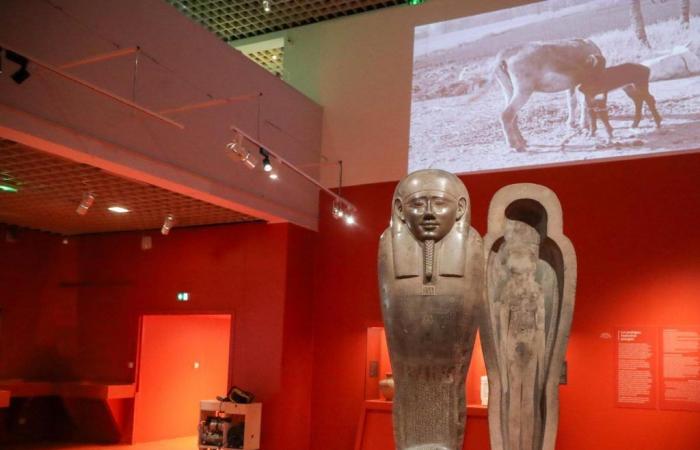Ct’s the big exhibition of the summer at the Musée d’Aquitaine, and one of the cultural events which will mark the tourist season in Bordeaux. Until November 3, the museum of history and anthropology is interested in Greco-Egyptian civilization. This civilization which spread over three centuries, from the conquest of Alexander the Great (332 BC) to the Battle of Actium (30 BC), and whose best-known figure is Queen Cleopatra VII, popularized by the cinema (Elizabeth Taylor, Monica Bellucci…) or the famous Asterix comic strip.
Laurent Theillet/SO
The space dedicated to the figure of Cleopatra, the best-known personality of Ptolemaic Egypt.
One room is also exclusively dedicated to this queen. There are posters and film clips, collectible figurines, video game projections, magazines: everything that fed the legend of a femme fatale, a nymphomaniac, obsessed with luxury and excess. “An image that was formed during the reign of Emperor Octavian, with whom she was in conflict, and which was perpetuated afterwards,” explains Sophie Griselle, the exhibition coordinator.
“Between classical Greece and the Roman Empire, Ptolemaic Egypt radiated throughout the Mediterranean basin”
Here, however, it is not a question of rehabilitating the queen – “That could be the subject of a single exhibition” – but of raising awareness of a civilisation that is not limited to the figure of Cleopatra. “Between classical Greece and the Roman Empire, Ptolemaic Egypt radiated throughout the Mediterranean basin,” explains Laurent Védrine, director of the Musée d’Aquitaine. “It was nourished by exchanges, crossbreeding, and sometimes tensions. The most recent research has shown that Egyptian and Greek cultures mixed at all levels of society.”
Ch. L.
Seals depicting Greek kings wearing Egyptian hairstyles.
Temple to Isis
The exhibition is in fact based on excavations or deciphering of papyrus carried out in recent years. They supplement loans (National Library of France, Louvre Museum, Musée des Confluences in Lyon, Gandur Foundation in Geneva, etc.) and pieces bequeathed to the City of Bordeaux by Jean-Ernest Godard, an amateur Egyptologist from the 19th century.e century, which had not left the reserves for a very long time. Notably the model of a temple dedicated to Isis, once built in Dendour, near present-day Sudan, and now kept at the Metropolitan Museum of Art in New York.
Laurent Theillet/SO
A model of a temple once built near present-day Sudan, now housed at the Metropolitan Museum of Art in New York.
The profusion of bronze deities clearly shows to what extent the cults were mixed. “The Greek kings very quickly understood that they had to obtain the support of the Egyptian clergy to legitimize their power,” explains Sophie Griselle. A stele loaned by the Louvre shows Queen Arsinoé elevated to the rank of divinity.
Laurent Theillet/SO
Bronze statuettes of deities which show how much the cults have mixed.
Another stele, which uses all the codes of Egyptian religious iconography, is accompanied by a text in Greek evoking Cleopatra. Seals and coins show Greek kings wearing typically Egyptian crowns or wigs. A statuette represents the god Serapis, inspired by Apis and Osiris, but displaying the same features as Zeus.
Laurent Theillet/SO
Impeccably preserved funeral masks.
Economic boom
In a room dedicated exclusively to funerary practices, we discover the sarcophagus of Dioskourides, general of King Ptolemy VI, Greek therefore, but mummified, in accordance with Egyptian rites. Other mummies, discovered between 1901 and 1902 by the archaeologist Pierre Jouguet, are represented in photos. Here, the interest lies in the cardboard boxes that surround them and which contain papyri, some of which are still being studied.
Laurent Theillet/SO
The papyri on display bear witness to an economic boom in Egypt before the Roman conquest. Some are still under study.
There are pieces of mummy decoration, with surprisingly preserved bright colours, and above all texts that are all testimonies of a society in full economic boom. The increase in arable land, the development of trade with other countries and the generalisation of money appear through quotes, tax collection registers or documents reporting work in agricultural areas. But there are also literary documents, such as this papyrus presenting an extract from “The Odyssey” dating from the 3rd centurye century BC. It is one of the oldest known copies of the text attributed to Homer.
The exhibition can also be visited (especially?) for the pleasure of the eyes. For the monumental side of the sarcophagi, the hieratic appearance of a sphynx statue, the beauty of the funerary masks, the finesse of the jewelry or statuettes of divinities. Egypt still fascinates in 2024. And in Bordeaux, it has not given rise to an archaeological exhibition for thirty-two years.
Tuesday to Sunday from 11 a.m. to 6 p.m. 2 to 6 euros. musee-aquitaine-bordeaux.fr






